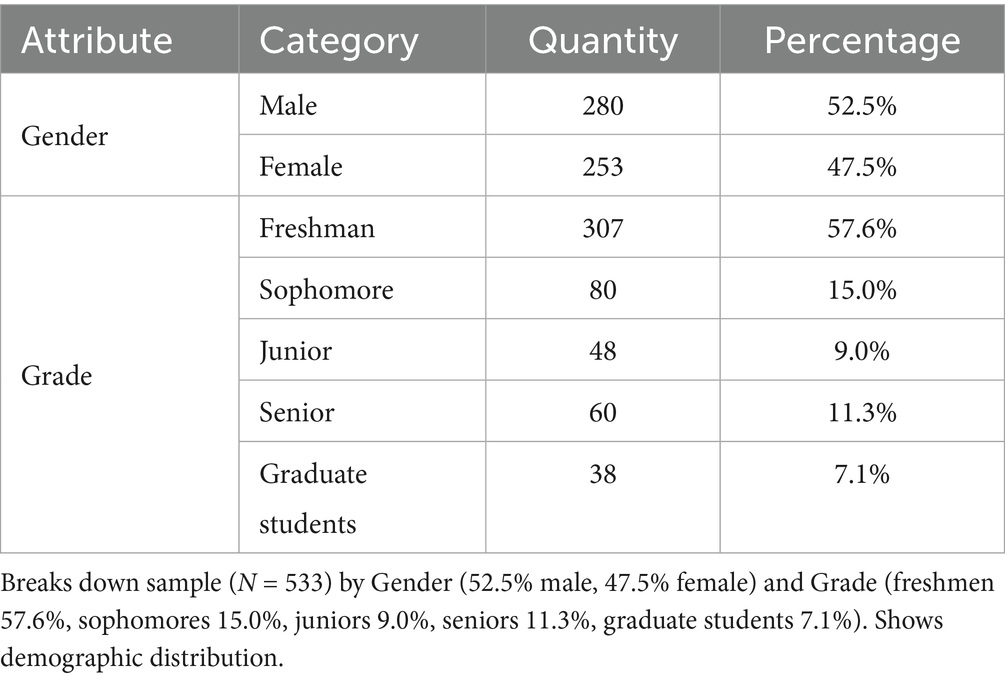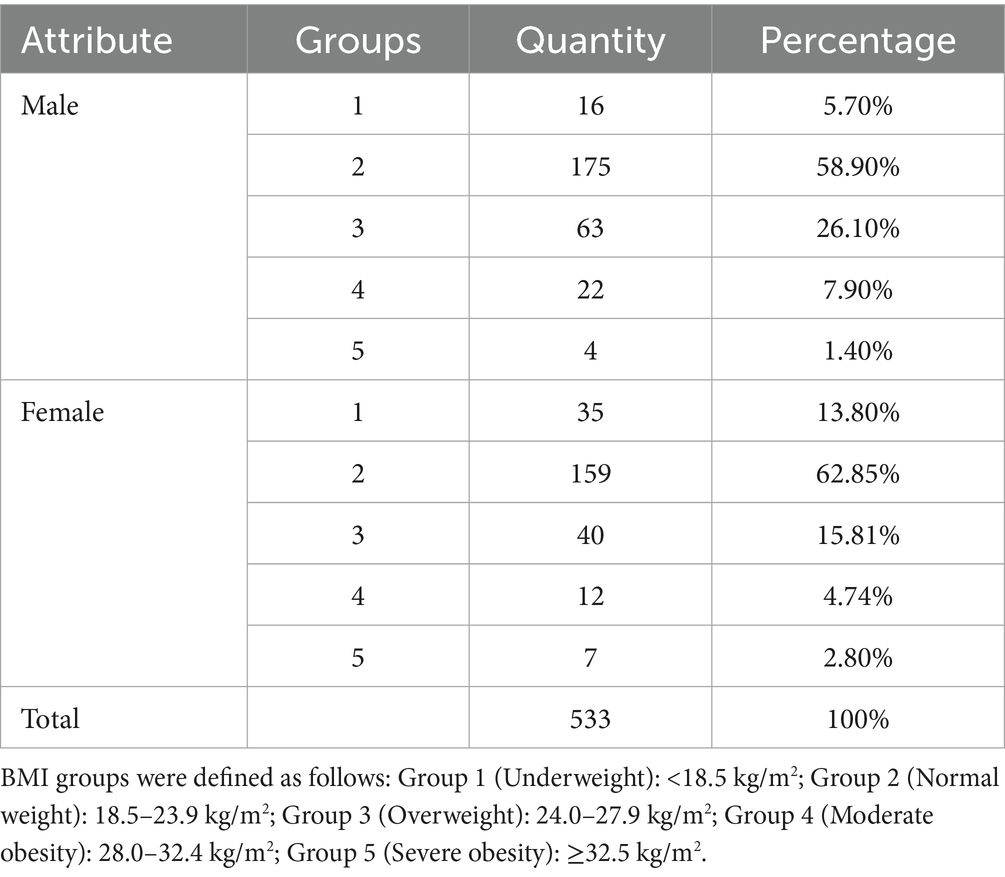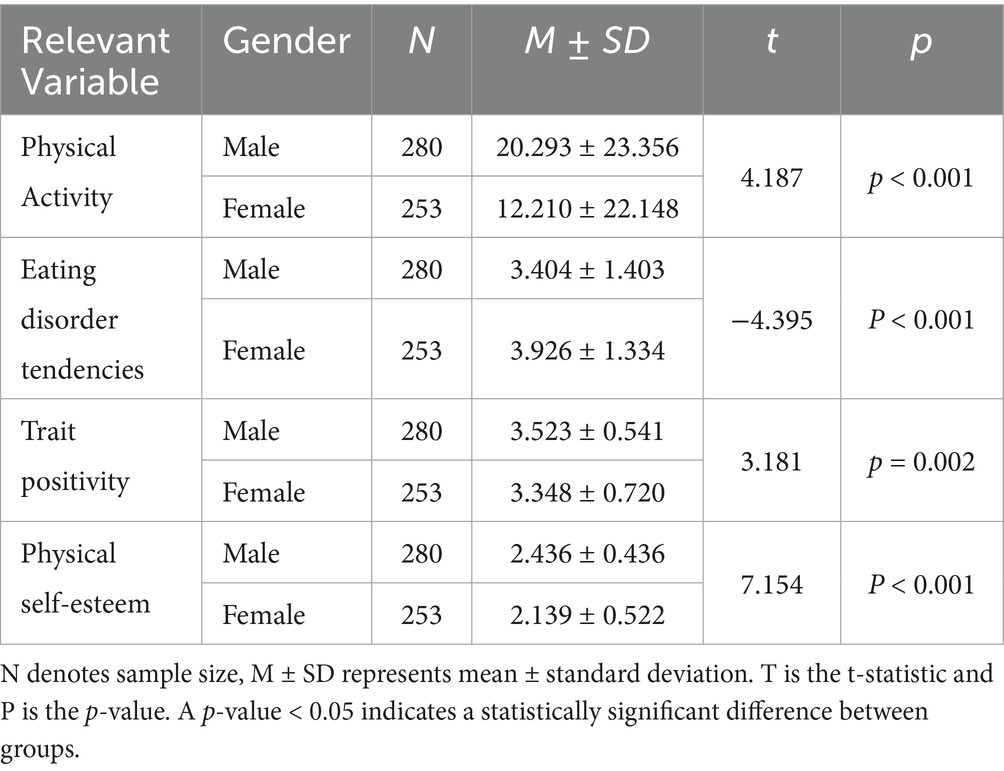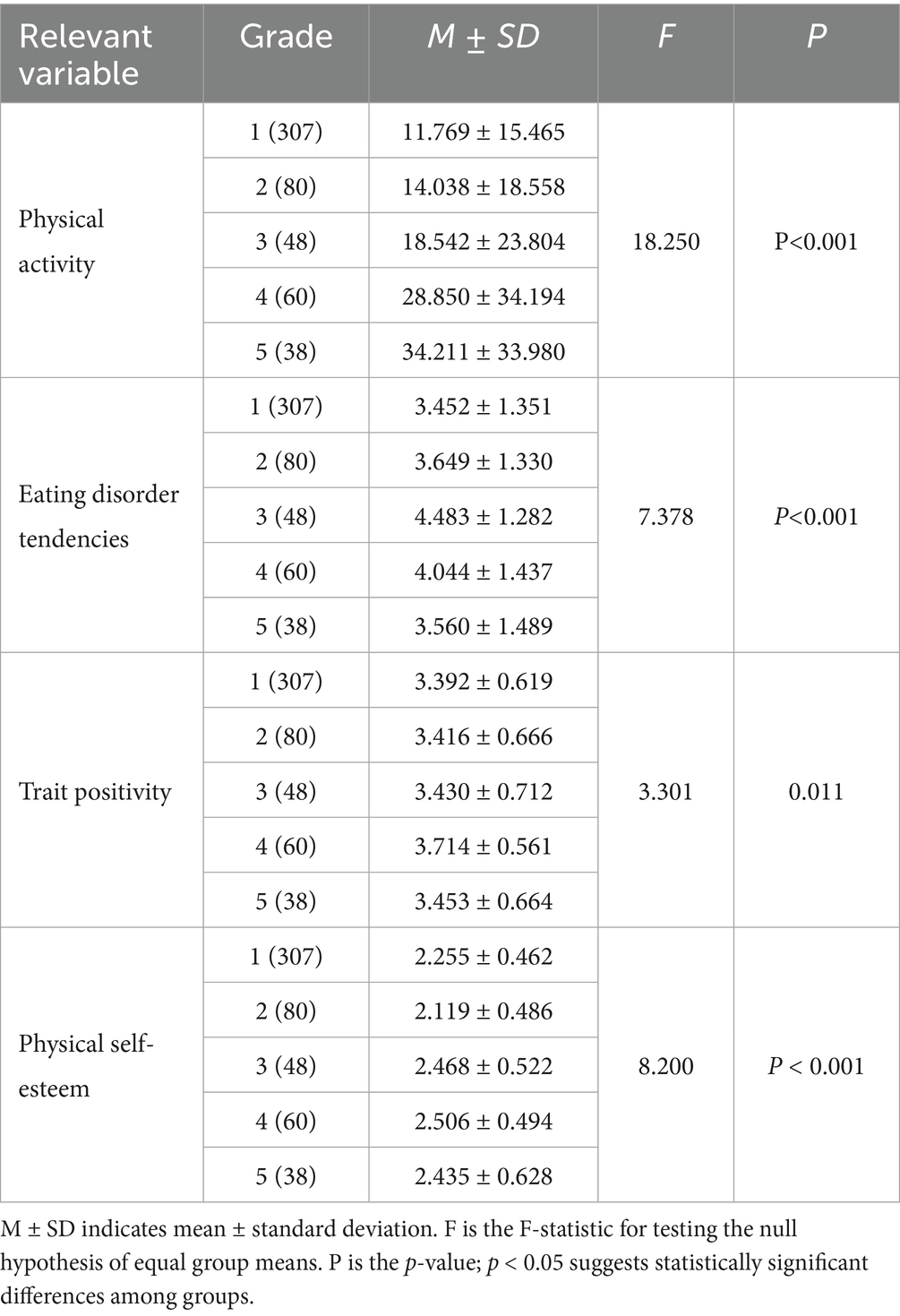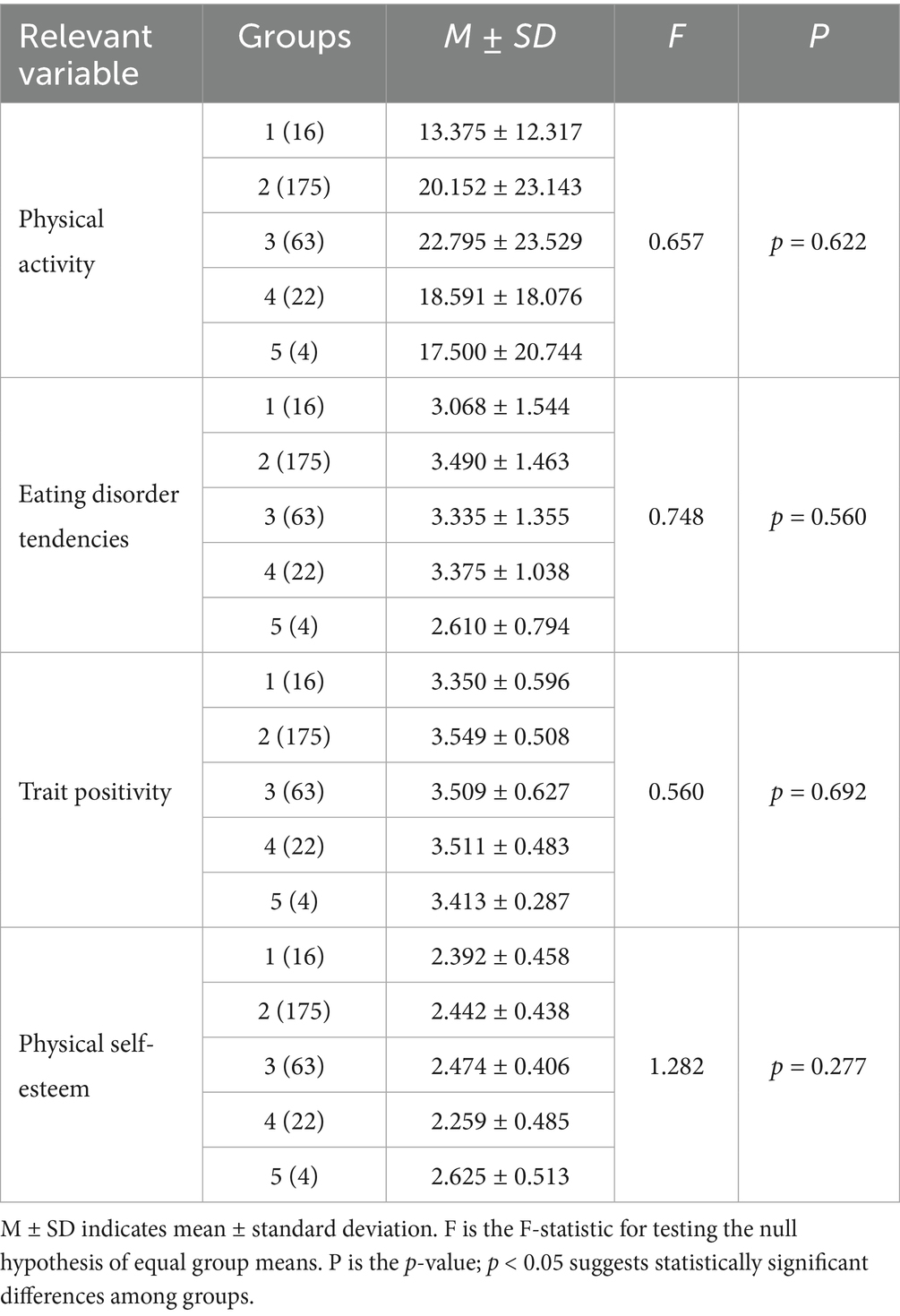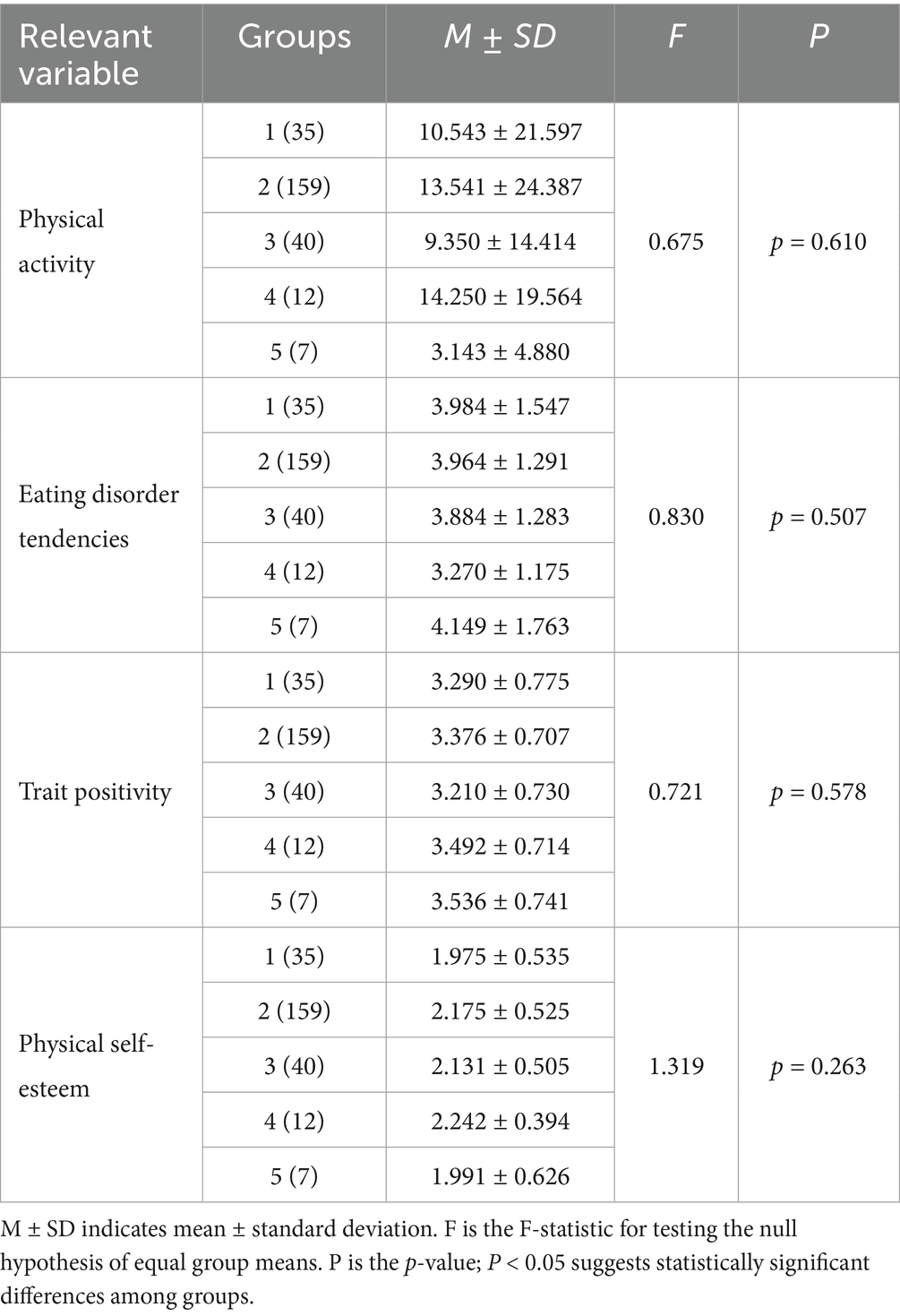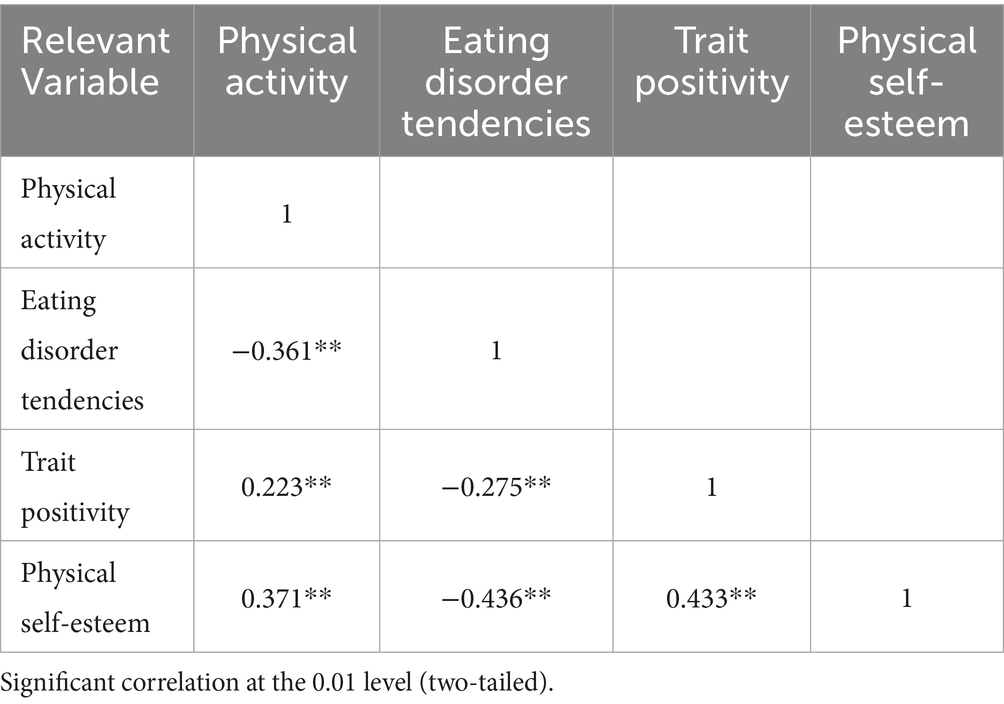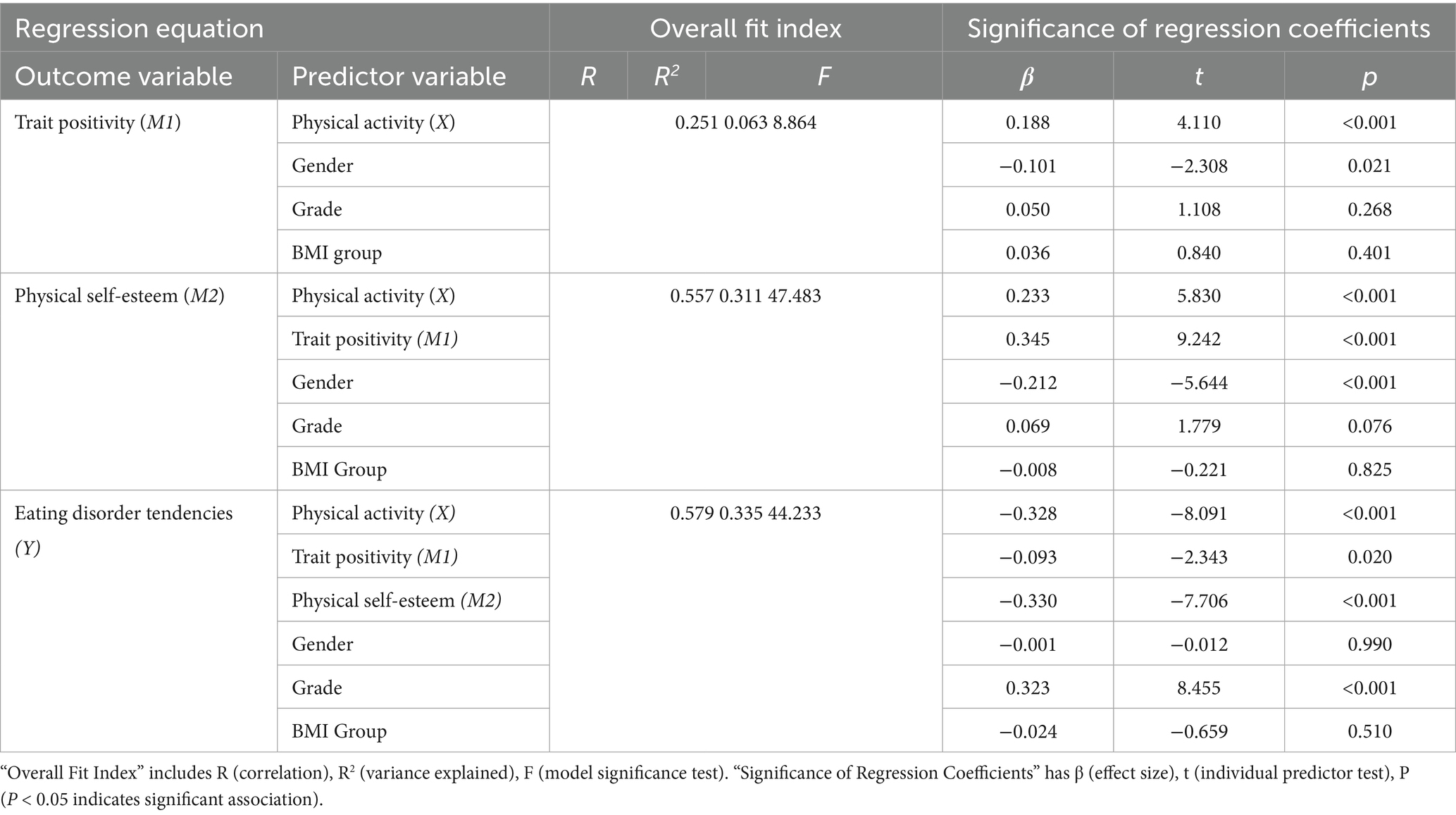- School of Physical Education, Liaoning Normal University, Dalian, China
Aim: This study aimed to explore the influence mechanism of physical activity on eating disorder tendencies in college students and analyze the chain-mediated role of trait positivity and physical self-esteem.
Methods: Using the Physical Activity Rating Scale, Eating Disorder Tendency Scale, Trait Positivity Scale, and Physical Self-Esteem Scale, 550 college students from four universities in Northeast China were surveyed.
Results: (1) Physical activity was significantly negatively correlated with eating disorder tendencies in college students (r = −0.361; p < 0.01); trait positivity was significantly negatively correlated with eating disorder tendencies in college students (r = −0.275; p < 0.01); physical self-esteem was significantly negatively correlated with eating disorder tendencies in college students (r = −0.436; p < 0.01); physical activity was significantly positively correlated with trait positivity (r = 0.223; p < 0.01); physical activity was significantly positively correlated with physical self-esteem (r = 0.371; p < 0.01); trait positivity was significantly positively correlated with physical self-esteem (r = 0.433; p < 0.01). (2) Physical activity could negatively predict eating disorder tendencies in college students, with a direct effect of −0.0202. (3) In the association between physical activity and eating disorder tendencies in college students, trait positivity and physical self-esteem could exert both separate mediating effects and a chain-mediated effect, with effect values accounting for 4.02, 17.23, and 4.76% of the total effect, respectively.
Conclusion: Physical activity is associated with eating disorder tendencies in college students, and this association occurs both through the mediating roles of trait positivity and physical self-esteem and through their chain-mediated effect.
1 Introduction
Eating disorder tendencies refer to abnormal dietary behaviors that not only pose serious threats to individuals’ physical health but may also trigger psychological problems including depression and anxiety, and even lead to self-harm and suicidal thoughts (Wei, 2025). The causes of eating disorder tendencies are complex, involving physiological, familial, psychological, and social dimensions (Weems, 2023). College students, as a special group undergoing critical life transitions, experience significant physiological, psychological, and social role changes during this period (Ning and Yu, 2024). Although possessing higher education levels and self-awareness, they simultaneously endure pressures from academics, career planning, and interpersonal relationships (Yang H. H., 2024). Consequently, the detection rate of eating disorder tendencies in college students is relatively high and shows an increasing trend. Specifically, between 2011 and 2021, the detection rate was significantly higher than during 2002–2010, highlighting the severity of this issue (Liu et al., 2022). Physical activity plays a crucial role in mitigating eating disorder tendencies by enhancing physical health, regulating the relationship between perfectionism and eating disorder tendencies, improving psychological well-being, promoting positive physical self-evaluation, and reducing abnormal eating behaviors (Zhang et al., 2018). However, some studies indicate that participation in certain specific types of exercise may exacerbate individuals’ concerns about physical appearance, thereby adversely affecting recovery from eating disorder tendencies (Wang et al., 2022). Physical self-esteem is an individual’s subjective evaluation of their body: high levels lead to positive acceptance, while low levels may trigger negative emotions. Trait positivity, a stable personality trait, reflects constant and automatic awareness of present experiences. Both trait positivity and mindfulness emphasize present-moment awareness and non-judgment for mental health benefits. The key difference is that trait positivity is an inherent personal tendency, while mindfulness relies on systematic training. Therefore, in-depth research on how physical activity reduces eating disorder tendencies in college students by enhancing physical self-esteem and trait positivity is essential for promoting physically and mentally healthy development in this population.
2 The chain-mediated hypothetical model of the relationship between physical activity and eating disorder tendencies in college students
2.1 Predictive effects of physical activity and the eating disorder tendencies in college students
Physical activity is a form of bodily movement involving planned, structured, and repetitive physical actions aimed at improving or maintaining one or more components of physical health (American College of Sports Medicine, 2018). Physical activity encompasses not only vigorous forms of exercise but also gentle movement modalities that facilitate emotional relaxation, cultivate temperament, and enhance psychological well-being (Huang et al., 2013). By promoting healthy lifestyles, Physical activity can not only prevent eating disorder tendencies but also foster appreciation for one’s body, eliminate negative fears about appearance, and strengthen individuals’ sense of value and meaning through its fitness and educational function (Raisi et al., 2023). Furthermore, habitual engagement in Physical activity helps college students integrate into sports communities, experience the pleasure derived from movement, and enhances their capacity to cope with setbacks and anxiety (Qin and Qin, 2023). As a purposeful bodily endeavor, physical activity fundamentally aims to improve or sustain physical health levels (American College of Sports Medicine, 2011). Based on this, we propose hypothesis H1: Physical activity negatively predicts eating disorder tendencies in college students.
2.2 Prediction of the mediating effect of trait positivity
Trait positivity refers to an individual’s ability to maintain awareness and focus on present-moment experiences (Brown and Ryan, 2003). It is influenced by both innate factors and acquired factors such as education and interventions (Duan, 2014). Trait positivity and mindfulness both focus on awareness and concentration to enhance mental health, with the former being a stable personality trait and the latter an acquired practice. Training to enhance trait positivity has been shown to alleviate physical discomfort in patients with anorexia and help individuals break free from the control of emotions and thoughts, reducing binge eating behaviors (Wang et al., 2021).
Trait positivity also improves self-control over eating behaviors, enhances food awareness, and modifies unhealthy dietary habits (Liang et al., 2022). Individuals with high levels of Trait Positivity typically exhibit stronger emotional regulation and acceptance abilities. Even after overeating, they can regulate subsequent negative emotions and reduce binge eating or purging behaviors (Hussain et al., 2021). Physical activity is recognized as being associated with individuals’ trait positivity levels, enabling participants to focus more intently on present-moment sensations during exercise and derive satisfaction from the process (Xu, 2021). Based on this, we propose hypothesis H2: Trait positivity negatively predicts eating disorder tendencies in college students, thereby playing a mediating role in the relationship between physical activity and eating disorder tendencies in college students. This process not only promotes physical health but also provides college students with a comprehensive pathway for preventing and intervening in eating disorder tendencies.
2.3 Prediction of the mediating effect of physical self-esteem
The other mediator selected in this study is physical self-esteem. Physical self-esteem refers to individuals’ satisfaction with their bodies, encompassing physical attractiveness, athletic skills, physical condition, and fitness (Fox and Corbin, 1989). Individuals with higher physical self-esteem typically demonstrate stronger emotion regulation abilities (Ma and Wang, 2021). Existing research indicates a significant association between physical self-esteem and eating disorder tendencies in college students: higher physical self-esteem correlates with lower eating disorder tendencies in college students, reduced body dissatisfaction, and fewer pathological eating behaviors (Li, 2022). Simultaneously, positive bodily perception and acceptance can mitigate the risk of eating disorder tendencies in college students (Wang et al., 2020). Studies confirm that physical activity serves as a crucial means to enhance physical self-esteem (Liao and Li, 2024), effectively promoting its development among students. This process strengthens self-identity, builds greater self-confidence, and enables more flexible and proactive responses to adversity (Li et al., 2019).
Physical self-esteem is essential for psychological well-being and life satisfaction, and its enhancement remains a key focus in university mental health initiatives (Sun and Zhang, 2020). As a multidimensional evaluation of one’s physical condition, attractiveness, and other factors, physical self-esteem is closely linked to bodily movement. Multiple studies have verified physical activity’s significant positive predictive effect on physical self-esteem—that is, regular physical activity promotes higher physical self-esteem levels (Zhu and Chen, 2009; Jia et al, 2018). Based on this, we propose Hypothesis H3: Physical self-esteem negatively predicts eating disorder tendencies in college students, thereby playing a mediating role in the relationship between physical activity and eating disorder tendencies in college students.
2.4 Prediction of the chain-mediated effect of trait positivity and physical self-esteem
Trait positivity predicts physical self-esteem and regulates psychological well-being (Wang et al., 2020). As an ability to maintain awareness and focus on present-moment experiences, clinical psychology research confirms that trait positivity effectively improves negative thought patterns in patients with psychological disorders, thereby enhancing individuals’ physical self-esteem levels (Wang and Sun, 2018). Furthermore, health psychology studies indicate that trait positivity interventions mitigate the negative impact of psychological stress on physical self-esteem, serving as a protective factor for physical self-esteem (Yu, 2020). In educational psychology, trait positivity has been found to facilitate the development of positive self-perception in college students (Li and Zhang, 2019). Based on this, we propose Hypothesis H4: Trait positivity and physical self-esteem play a chain-mediated role between physical activity and eating disorder tendencies in college students (see Figure 1).
3 Methodology
3.1 Research subject
This study focused on exploring the effects of physical activity on eating disorder tendencies in college students and the chain mediating role of trait positivity and body esteem in. The study adopted a stratified random sampling strategy to select college students from different grades and distributed a total of 550 questionnaires to them. Among the recovered questionnaires, 17 questionnaires were excluded which were regarded as invalid due to extreme responses, incomplete responses or not completed within the specified time, and finally 533 valid questionnaires were successfully recovered, with a high validity recovery rate of 96.91%.
3.2 Research method
3.2.1 Literature method
The literature method is the basis of this study. By systematically collecting and analysing literature in related fields, we aim to construct a theoretical framework and identify gaps and controversial points in the study. Various types of literature including academic journal articles, conference papers, official reports and books were widely collected to ensure a solid and comprehensive theoretical foundation for the study.
3.2.2 Questionnaire survey method
Questionnaire survey method, as a quantitative research tool, collects data through a well-designed set of standardised questions. In this study, questionnaire survey method was used to collect data by selecting mature questionnaires and selecting participants through random sampling to ensure a representative sample, distributing the questionnaires and collecting them to collect the required data.
3.2.3 Mathematical and statistical method
The study carried out data analysis with the help of SPSS 29.0 statistical software. At the preliminary stage of data processing, Cronbach’s alpha coefficient was applied to assess the reliability of the data and Harman’s one-way test was used to troubleshoot the possible problem of common method bias in the data collection process. The collected data were entered into SPSS software and the demographic characteristics of the sample were carefully analysed using descriptive statistics. In addition, the correlations between physical activity, eating disorder tendencies in college students, and trait positivity and body esteem were explored in depth by calculating Pearson correlation coefficients. Finally, a comprehensive analysis of the study was completed by performing multiple regression analyses using Model 6 in the PROCESS macro program and assessing the significance level of the mediating effect with the help of Bootstrap test.
3.3 Research instruments
3.3.1 Physical activity level scale
The scale adopted in this study was developed by Japanese scholar Hashimoto Kimio (Liang, 1994) to assess participants’ physical activity during the previous week. This scale comprehensively evaluates three key dimensions of physical activity: intensity, duration, and frequency, using a 5-point Likert scale. According to the formula “Total score = Intensity × Frequency × Duration - 1,” higher scores indicate a higher level of physical activity (Han et al., 2024).
3.3.2 Eating disorder tendency scale
This study employed the Eating Disorder Inventory (EDI) developed by Garner et al. (1983), a widely used screening tool for assessing individuals’ risk of eating disorder tendencies. The EDI-3 Referral Form (EDI-3RF) version was adopted to identify individuals at high risk of eating disorder tendencies (Garner, 2004). This questionnaire comprises 25 items rated on a six-point scale, with higher total scores indicating more severe manifestations of eating disorder tendencies in the measured dimensions. The Cronbach’s alpha coefficient was 0.973.
3.3.3 Philadelphia trait positivity scale
The Philadelphia Trait Positivity Scale was developed by Cardaciotto et al. (2008) based on Bishop et al.’s (2004) conceptualization, positing that trait positivity comprises two components: awareness and acceptance. Consequently, this scale conceptualizes trait positivity not as a second-order factor but as two distinct yet interrelated dimensions. Since this study emphasizes the acceptance-oriented aspect of trait positivity, this scale was selected to measure trait positivity. The Cronbach’s alpha coefficient was 0.751.
3.3.4 Physical self-esteem scale
This study adopted the Body Esteem Scale (BES) revised by Chinese scholars Xu Xia and Yao Jiaxin for the psychological assessment of college students (Xu and Yao, 2001). The scale employs a 4-point rating system, with higher scores indicating a higher level of physical self-esteem. The Cronbach’s alpha coefficient was 0.951.
4 Research results
4.1 Control and test of common method bias
In this study, in order to ensure the accuracy of the data and to exclude the effect of common method bias, the Harman one-way test was used to test for common method bias. All scale questions were included in an exploratory factor analysis without rotation, and the test results showed that the number of factors with eigenvalues greater than 1 reached nine, indicating that the data were not dominated by a single factor, and that the variance explained by the largest factor was 26.124%, a percentage that is lower than the 40% critical criterion proposed by Podsakoff et al. (2003). Therefore, the data in this study were not affected by serious common method bias and the reliability of the results was guaranteed.
4.2 G-power test
To verify the support of the sample size for the chain-mediated model, a post hoc power analysis was performed using G-Power 3.1.9.2 with “F tests → Linear multiple regression.” The parameters were set as follows: effect size f2 = 0.504 (converted from the R2 of the dependent variable), significance level α = 0.05, sample size N = 533, and number of predictors k = 3. The analysis showed that the power was 1.00 (see Table 1), indicating that the sample size was extremely sufficient to effectively detect the model effects.
4.3 Descriptive statistics
Demographic analysis showed that the sample size of this study was 533, with slightly more males than females, 52.5 and 47.5%, respectively. In terms of grade distribution, freshmen had the highest percentage of 57.6%, while graduate students had the lowest percentage of 7.1%. The proportions of sophomores, juniors and seniors were 15.0, 9.0 and 11.3%, respectively. This indicates that the sample is mainly concentrated on first-year students, with relatively small numbers of students in other grades (see Table 2).
When examining study variables, college students’ individual BMI values also correlate with other variables; therefore, data were analyzed separately by gender. First, participants’ age, height, and weight were grouped according to the categorization standards from the.
Chinese National Physical Fitness Monitoring Bulletin (General Administration of Sport of China, 2022) (results shown in Table 3). Subsequently, BMI values were calculated for each participant and grouped based on BMI magnitude according to Asian adult BMI classification criteria, with underweight (Group 1) defined as below 18.5, normal weight (Group 2) as 18.5 ~ 23.9, overweight (Group 3) as 24.0 ~ 27.9, moderate obesity (Group 4) as 28.0 ~ 32.4, and severe obesity (Group 5) as ≥32.5 (National Health Commission of the People’s Republic of China, 2024) (results shown in Table 4).
In addition, the sample was subjected to an independent samples t-test, which was first divided into two groups of men and women to compare whether there was a significant difference in each variable between the genders, and the results of the data measurements are shown in Table 5.
The results of the independent samples t-test showed that there were significant differences between male and female groups across all four variables. Given that such gender differences may impact the relationship between physical activity and eating disorder tendencies, while also interfering with the chain - mediated effects of trait positivity and physical self - esteem, gender was included as a covariate in the subsequent regression and chain - mediated models. This was to control the potential influence of this confounding factor on the relationships among the core variables and ensure the accuracy and validity of the research findings.
4.4 ANOVA single factor analysis
Firstly, ANOVA one-way analysis was used to analyse the differences in physical activity, eating disorder tendency, trait positivity and Physical Self-Esteem among college students of different grades. The results showed that freshmen and junior and senior students showed significant differences in the physical activity dimension. As shown in Table 6.
To clearly present differences in physical activity, eating disorder tendencies in college students, trait positivity, and physical self-esteem across academic years, multiple comparison analyses were conducted with the following results:
Physical Activity: Significant differences emerged between graduate students and freshmen (mean difference = −25.44180*), sophomores (−23.17303*), and juniors (−18.66886*); between seniors and freshmen (−17.08127*), sophomores (−14.81250*), and juniors (−10.30833*). No significant differences were observed between juniors and freshmen/sophomores, or between sophomores and freshmen (* Indicates significant mean difference at the 0.05 level. Means for each grade are shown in parentheses, and the same applies hereinafter).
Eating Disorder Tendencies in College Students: Significant differences existed between graduate students and juniors (−0.88439*); seniors and freshmen (−0.59175*); juniors and freshmen (−1.03109*) or sophomores (−0.83483*). All other inter-year comparisons were non-significant.
Trait Positivity: Significant differences occurred between seniors and freshmen (−0.32209*), and juniors and sophomores (−0.29792*). All other comparisons were non-significant.
Physical Self-Esteem: Significant differences were found between postgraduate students and freshmen (−0.18026*) or sophomores (−0.31592*); seniors and freshmen (−0.25072*) or sophomores (−0.38639*); juniors and freshmen (−0.21322*) or sophomores (−0.34889*); and sophomores and freshmen (0.13567). All other inter-year differences were non-significant.
Secondly, men and women were divided into two groups according to gender, and each group was analysed by ANOVA one-way analysis of the differences between college students with different BMI levels in each variable. The data results of male college students in different BMI level groups are shown in Table 7.
One - way ANOVA results indicated that, for the male college student population, there were no statistically significant differences in the inter - group comparisons of the four variables s, namely Physical Activity, Eating Disorder Tendencies, Trait Positivity, and Physical Self - Esteem, among different BMI groups. Since the overall inter - group differences in the one - way ANOVA did not reach the level of statistical significance (p > 0.05), there was no need to conduct post - hoc tests to further explore the specific differences between groups.
The results of the data of female college students in different BMI level groups are shown in Table 8.
One - way ANOVA results indicated that, for the female college student population, there were no statistically significant differences in the inter - group comparisons of the four variables, namely Physical Activity, Eating Disorder Tendencies, Trait Positivity, and Physical Self - Esteem, among different BMI groups. Given that the overall inter - group differences in the one - way ANOVA did not reach statistical significance (p > 0.05), post - hoc tests were not conducted to further examine the specific differences between groups.
4.5 Correlation analysis between variables
Using SPSS software, correlation analyses were performed by importing the four variables—physical activity, eating disorder tendencies in college students, trait positivity, and physical self-esteem—into the dataset. Calculation of Pearson correlation coefficients (Table 9) revealed a significant negative correlation between physical activity and eating disorder tendencies in college students, indicating that higher frequency of participation in physical activity corresponds to a lower likelihood of developing eating disorder tendencies. Furthermore, physical activity showed significant positive correlations with both trait positivity and physical self-esteem, suggesting that individuals who regularly engage in physical activity tend to exhibit higher levels of trait positivity and physical self-esteem. Simultaneously, both trait positivity and physical self-esteem demonstrated significant negative correlations with eating disorder tendencies in college students, implying that higher levels of trait positivity and stronger physical self-esteem are associated with lower eating disorder tendencies. The results indicate that physical activity, trait positivity, and physical self-esteem play important roles in preventing and intervening in eating disorder tendencies in college students.
To investigate the relationships among physical activity (X), demographic variables (gender, academic year, BMI groups), trait positivity (M1), physical self-esteem (M2), and eating disorder tendencies in college students (Y), this study employed hierarchical multiple linear regression analysis with stepwise entry of predictors. Using trait positivity, physical self-esteem, and eating disorder tendencies in college students as dependent variables, we sequentially examined the explanatory power of physical activity and demographic variables. Model fit indices and significance levels of regression coefficients are presented in Table 10. Results demonstrated that physical activity and specific demographic variables significantly predicted trait positivity and physical self-esteem, with a chain-mediated effect through trait positivity → physical self-esteem ultimately influencing eating disorder tendencies in college students. These findings provide empirical evidence for elucidating the psychological mechanisms underlying eating behaviors in college students.
4.6 Chain-mediated effects of trait positivity and physical self-esteem between physical activity and eating disorder tendencies
Trait positivity and physical self-esteem act as chain mediators between physical activity and eating disorder tendencies. Physical activity reduces eating disorder tendencies by enhancing trait positivity, which in turn enhances physical self-esteem. This chain-mediated effect suggests that physical activity not only directly positively affects eating disorder tendency, but also indirectly affects eating disorder tendency through the psychological machines (trait positivity and physical self-esteem), the data results of which are shown in Table 11, and the model diagram is shown in Figure 2.
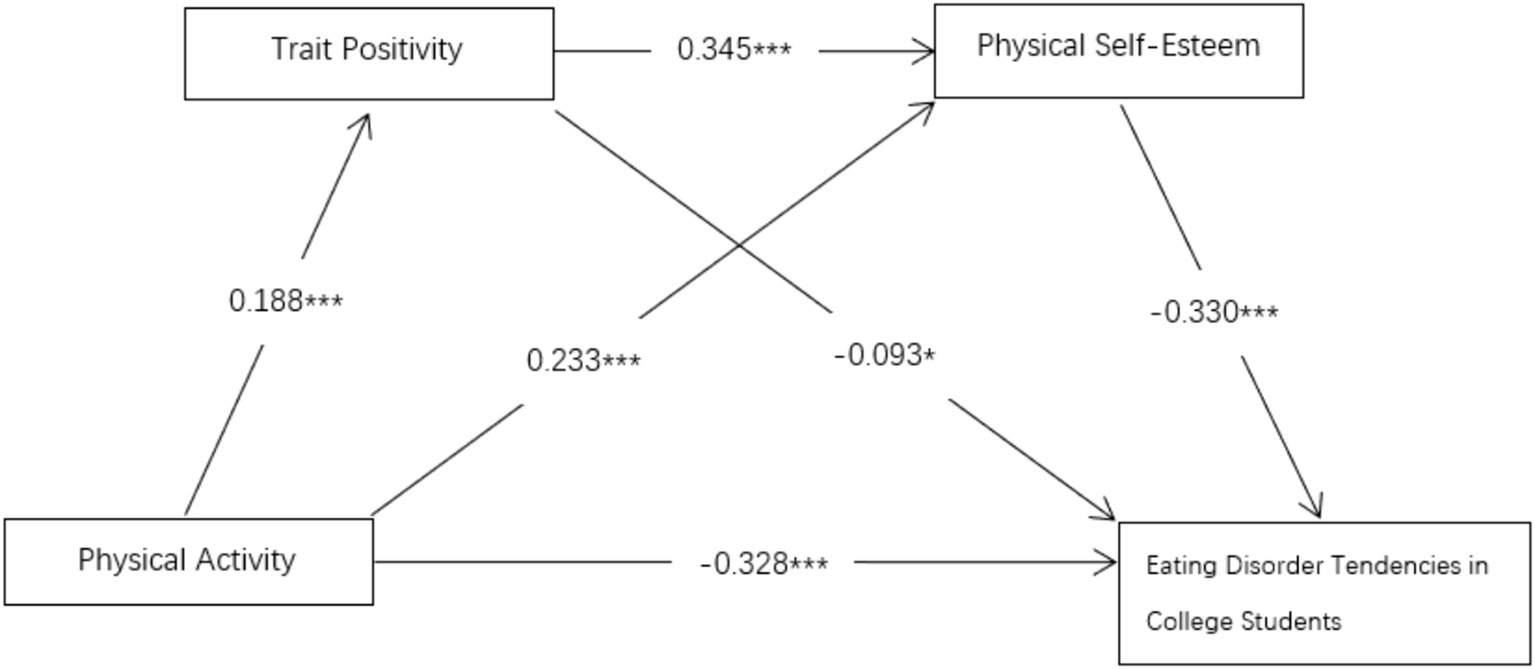
Figure 2. Chain brokerage model diagram. The values in this figure were generated from the β and p in Table 10. In this figure, p-values less than 0.001 are represented by three stars, indicating high significance; p-values less than 0.01 are shown as two stars, denoting extreme significance; and p-values less than 0.05 are marked by one star, indicating significance.
5 Discussion
5.1 Group difference analyses
Using independent samples t-tests, results indicated that males generally engaged in physical activity more actively, while females exhibited higher vulnerability to eating disorder tendencies in college students, consistent with prior research (Beaulieu and Best, 2024). Variations in hormone levels may contribute to gender differences in eating disorder tendencies among college students (Versini et al., 2010). Additionally, females’ emphasis on perfectionism (Culbert et al., 2021) and self-objectification psychology (Fredrickson and Roberts, 1997) were key factors. Regarding trait positivity, males demonstrated greater present-moment focus and reduced reactivity to negative emotions, potentially linked to hormonal differences, gender-specific emotion regulation patterns, and females’ higher self-compassion levels (Bleidorn et al., 2016). For physical self-esteem, males reported more positive body image evaluations and fewer body image concerns (Gualdi-Russo et al., 2022).
Univariate ANOVA across academic years revealed significantly increased physical activity scores in higher grades, particularly from junior to postgraduate stages. This may reflect enhanced time management skills, greater health awareness, and proactive health behaviors (Carducci et al., 2020), alongside increased leisure time and resource access (Guo et al., 2024). Eating disorder tendencies peaked during junior year, potentially due to academic pressure and career uncertainty prompting maladaptive eating behaviors (Yang, 2011), then decreased in senior and postgraduate years as future plans solidified (Zheng, 2024). Trait positivity scores were highest among seniors, possibly indicating stress-coping strategies during graduation transitions (Ouyang et al., 2019), while stable scores in lower grades suggested underdeveloped mindfulness habits (Hu and Gu, 2024). Physical self-esteem improved in junior/senior years, reflecting increased body acceptance, whereas freshmen/sophomores showed lower scores due to heightened appearance focus and social evaluation (Zhang and Song, 2008).
In this study, no significant differences were observed across various variables among different BMI groups within male and female college student populations. This may be attributed to the interactive effects of multiple factors. At the physiological level, as a broad body shape indicator, BMI fails to fully capture the subtle differences in body composition (such as muscle mass and body fat distribution) within genders among college students, limiting its predictive power for behavioral and psychological variables (Verma et al., 2016). In terms of environment, uniform campus dietary and exercise resources (Zhou and Zeng, 2025) may weaken the potential impact of BMI on physical activity and eating behavior. Additionally, external factors such as academic stress and social culture may have a stronger driving effect on psychological traits (such as trait mindfulness and physical self-esteem) in both genders (Woolley, 1903). Regarding psychological traits, gender-specific psychological tendencies, such as females’ focus on body image (Zhao, 2022) and males’ pursuit of achievement (Yang Q. W. et al., 2023), may obscure the role of BMI. It is worth noting that this finding diverges from previous studies on adult populations (Li, 2024; Zhang, 2024), which may stem from the unique developmental stage characteristics of college students, altering the influence pathway of BMI on behavior and psychology in this group. However, this study is limited to college students and uses BMI as a single grouping indicator, failing to comprehensively consider key body composition factors such as body fat percentage and muscle mass, which may affect the interpretation of results. Therefore, this study has limitations. Future research could incorporate more refined body measurement indicators, adopt longitudinal tracking designs, and expand sample diversity to deeply explore the relationships among BMI, health behaviors, and psychological variables.
5.2 Main effect analysis of physical activity on eating disorder tendencies in college students
Results demonstrated a significant negative correlation between physical activity and eating disorder tendencies in college students, with physical activity effectively and negatively predicting eating disorder tendencies, thereby validating Hypothesis H1. Specifically, physical activity actively contributes to the treatment of binge eating disorder, significantly reducing binge eating behaviors and associated symptoms (Guerriero et al., 2025). Furthermore, physical activity aids in effectively managing compulsive exercise behavior—a key risk factor for eating disorder tendencies (Li et al., 2024).
As an efficacious psychological intervention, physical activity significantly enhances emotion regulation. It effectively alleviates anxiety and stress, which frequently trigger eating disorder tendencies (Zhao et al., 2024). Social pressure also constitutes a critical risk factor for eating disorder tendencies (Monteleone et al., 2020), physical activity mitigates this pressure by improving individuals’ adaptability to social evaluation, thereby reducing eating disorder tendencies induced by social stressors (Wu et al., 2025). Additionally, physical activity provides a positive social environment conducive to establishing healthier interpersonal relationships (Zhang, 2023).
Universities should actively encourage student participation in physical activity and offer diversified physical activity programs alongside trait positivity training courses to comprehensively promote students’ physical and mental health. This approach not only prevents and reduces eating disorder tendencies in college students but also enhances their overall quality of life.
5.3 Chain-mediated effect analysis of trait positivity and physical self-esteem
This study constructed a model with trait positivity and physical self-esteem as mediators to examine how physical activity influences eating disorder tendencies in college students. Results confirmed that trait positivity mediated the relationship between physical activity and eating disorder tendencies in college students, validating Hypothesis H2. Physical activity significantly and positively predicted trait positivity levels. Research indicates that physical activity enhances psychological well-being by elevating trait positivity (Sala et al., 2022). Individuals with higher trait positivity exhibit protective effects against pathological mechanisms of eating disorder tendencies, characterized by improved emotional expression, acceptance of discomfort during eating, and reduced hyperfocus on food/body sensations—processes significantly linked to lower eating disorder tendencies (Giannopoulou et al., 2020). Concurrently, trait positivity training effectively manages compulsive exercise behavior (Bacalhau et al., 2025), a critical risk factor for eating disorder tendencies (Lichtenstein et al., 2017).
Second, findings revealed the mediating role of physical self-esteem between physical activity and eating disorder tendencies, confirming Hypothesis H3. Physical activity significantly and positively predicted physical self-esteem. Physically active individuals held more positive body perceptions, enhancing physical self-esteem (Yang C. et al., 2023), while higher physical self-esteem showed a significant negative correlation with eating disorder tendencies. Satisfactory body image substantially reduced eating disorder tendencies risk (Gao et al., 2024), improving mental health and overall quality of life. Enhanced physical self-esteem further strengthened school adaptability and psychological resilience (Winn and Cornelius, 2020), underscoring the imperative for educational policymakers to integrate physical activity into curricula.
Finally, the chain-mediated effect of trait positivity and physical self-esteem between physical activity and eating disorder tendencies in college students was confirmed (Hypothesis H4). Beyond direct effects, physical activity reduced eating disorder tendencies by elevating trait positivity (Zhao and Yin, 2024), thereby boosting physical self-esteem. Physiologically, trait positivity reduces stress-induced abnormal activation of body perception-related neural circuits, promoting objective awareness of the body (Yu et al., 2012); psychologically, trait positivity fosters acceptance of body image, shifting focus from flaws to positive physical experiences, thereby strengthening physical self-esteem (Xu, 2022). Individuals with higher trait positivity demonstrated greater physical self-esteem due to reduced stress reactivity, enhanced emotional stability, and increased body acceptance (Grepmair et al., 2007), mitigating body dissatisfaction. Higher physical self-esteem subsequently lowered vulnerability to eating disorder tendencies (Tian and Yang, 2024). Thus, physical activity indirectly reduced eating disorder tendencies through three pathways: the specific mediating role of trait positivity, the specific mediating role of physical self-esteem, and their chain-mediated effect. This chain-mediated mechanism provides novel insights into the physical activity–eating disorder tendencies relationship and offers empirical support for campus-based mental health interventions.
5.4 Practical implications and recommendations
Society should advocate for diverse aesthetic standards, avoiding the promotion of a singular “thin-ideal” beauty norm (Schroeder and Behm-Morawitz, 2024). Media must highlight healthy lifestyles across diverse body types and genders to foster inclusivity (Du and He, 2025). Communities should organize varied physical activity programs to encourage equal participation and dismantle gender stereotypes. Public awareness campaigns should increase understanding of eating disorder tendencies and related psychological issues, ensuring accessible professional counseling services.
In terms of educational institutions, they should fully leverage their guiding and educational roles. Based on the differences among college students of different grades in physical exercise, eating disorder tendencies, trait positivity, and physical self-esteem, the recommendations are as follows: strengthen the promotion of sports clubs and organize activities for lower-grade students (freshmen and sophomores) to cultivate exercise habits; incorporate a “Body Image and Healthy Diet” module integrated with trait positivity practices into the mental health courses for sophomores and juniors; implement grade-specific trait positivity curricula, establish workshops for sophomores, and engage senior students as “trait positivity peers”; combine trait positivity training with physical self-esteem cultivation, design specialized courses for lower-grade students, and integrate trait positivity elements into physical education teaching to promote physical and mental well-being.
College students ought to boost self - awareness and cultivate proper aesthetic and value systems to mitigate negative sociocultural impacts (Pan, 2025). Since physical activity can build a healthy lifestyle and augment physical self - esteem and psychological resilience, they should engage in sports actively. Managing emotions and alleviating stress via methods like Trait Positivity training and meditation is beneficial for psychological well - being (Zhang, 2025). Students need to focus on their own requirements and promptly seek professional assistance to avert the worsening of psychological issues.
6 Conclusion
Physical activity had a significant indirect effect on eating disorder tendencies in college students by enhancing trait positivity and physical self-esteem. This chain-mediated effect not only provides a new perspective for understanding the relationship between physical activity and eating disorder tendencies, but also provides empirical support for colleges and universities in promoting students’ mental health and preventing eating disorder tendencies. By encouraging students to participate in physical activity and combining it with trait positivity training, students’ trait positivity and physical self-esteem levels can be effectively enhanced, which in turn reduces eating disorder tendencies and promotes students’ overall health and quality of life.
Data availability statement
The raw data supporting the conclusions of this article will be made available by the authors, without undue reservation.
Ethics statement
The studies involving humans were approved by Ethics Committee of Liaoning Normal University. The studies were conducted in accordance with the local legislation and institutional requirements. The participants provided their written informed consent to participate in this study. Written informed consent was obtained from the individual(s) for the publication of any potentially identifiable images or data included in this article.
Author contributions
YJ: Formal analysis, Validation, Writing – review & editing. XM: Conceptualization, Investigation, Writing – original draft.
Funding
The author(s) declare that no financial support was received for the research and/or publication of this article.
Conflict of interest
The authors declare that the research was conducted in the absence of any commercial or financial relationships that could be construed as a potential conflict of interest.
Generative AI statement
The authors declare that no Gen AI was used in the creation of this manuscript.
Publisher’s note
All claims expressed in this article are solely those of the authors and do not necessarily represent those of their affiliated organizations, or those of the publisher, the editors and the reviewers. Any product that may be evaluated in this article, or claim that may be made by its manufacturer, is not guaranteed or endorsed by the publisher.
References
American College of Sports Medicine (2011). Quantity and quality of exercise for developing and maintaining cardiorespiratory, musculoskeletal, and neuromotor fitness in apparently healthy adults: guidance for prescribing exercise. Med. Sci. Sports Exerc. 43, 1334–1359. doi: 10.1249/MSS.0b013e318213fefb
American College of Sports Medicine (2018). ACSM'S guidelines for exercise testing and prescription. 10th Edn. Philadelphia, PA: Wolters Kluwer.
Bacalhau, S., Orange, L., Correia Junior, M., Bacalhau, S. P. O. S., Orange, L. G., Correia Junior, M. A. V., et al. (2025). Mindfulness-based interventions and their relationships with body image and eating behavior in adolescents: a scoping review. J. Eat. Disord. 13:77. doi: 10.1186/s40337-025-01238-6
Beaulieu, D. A., and Best, L. A. (2024). The intersection of physical activity type and gender in patterns of disordered eating. Sci. Rep. 14:18127. doi: 10.1038/s41598-024-68657-4
Bishop, S., Lau, M., Shapiro, S., Carlson, L., Anderson, N. D., Carmody, J., et al. (2004). Mindfulness: A proposed operational definition. Clinical Psychology: Science and Practice. 11, 230–241. doi: 10.1093/clipsy/bph077
Bleidorn, W., Arslan, R. C., Denissen, J. J., Rentfrow, P. J., Gebauer, J. E., and Potter, J. (2016). Age and gender differences in self-esteem—a cross-cultural window. J. Person. Soc. Psychol. 111, 396–410. doi: 10.1037/pspp0000078
Brown, K. W., and Ryan, R. M. (2003). The benefits of being present: mindfulness and its role in psychological well - being. J. Pers. Soc. Psychol. 84, 822–848. doi: 10.1037/0022-3514.84.4.822
Cardaciotto, L., Herbert, J. D., Forman, E. M., Moitra, E., and Farrow, V. (2008). The assessment of present-moment awareness and acceptance: the Philadelphia mindfulness scale. Assessment 15, 204–223. doi: 10.1177/1073191107311467
Carducci, B. J., Nave, C. S., and Nave, C. S. (2020). The Wiley encyclopedia of personality and individual differences: Personality processes and individual differences. Hoboken, NJ: John Wiley & Sons, Ltd. doi: 10.1002/9781119547174
Culbert, K. M., Sisk, C. L., and Klump, K. L. (2021). A narrative review of sex differences in eating disorders: is there a biological basis? Clin. Ther. 43, 95–111. doi: 10.1016/j.clinthera.2020.12.003
Du, L., and He, P. (2025). Research on the dissemination of short video aesthetic culture in the context of media convergence. China Media Technol. 2025, 77–81. doi: 10.19483/j.cnki.11-4653/n.2025.02.014
Duan, W. J. (2014). Disagreements of studies on mindfulness: Conceptualization and measurements. Adv. Psychol. Sci. 22, 1616–1627. doi: 10.3724/SP.J.1042.2014.1616
Fox, K. R., and Corbin, C. B. (1989). The physical self-perception profile: development and preliminary validation. J. Sport Exerc. Psychol. 11, 408–430.
Fredrickson, B. L., and Roberts, T. (1997). Objectification theory: toward understanding women’s lived experiences and mental health risks. Psychol. Women Q. 21, 173–206. doi: 10.1111/j.1471-6402.1997.tb00108.x
Gao, Z., Zhao, J., Peng, S., and Yuan, H. (2024). The relationship and effects of self-esteem and body shape on eating disorder behavior: a cross-sectional survey of Chinese university students. Healthcare 12:1034. doi: 10.3390/healthcare12101034
Garner, D. M. (2004). Eating disorder inventory-3 referral form (EDI-3RF). 3rd Edn. Lutz, FL: Psychological Assessment Resources (PAR).
Garner, D. M., Olmsted, M. P., and Polivy, J. (1983). Development and validation of a multidimensional eating disorder inventory for anorexia nervosa and bulimia. Int. J. Eat. Disord. 2, 17–36.
General Administration of Sport of China. (2022). Fifth national fitness monitoring bulletin. Beijing, China: China Institute of Sport Science. Available online at: https://www.sport.gov.cn/n315/n329/c24335066/content.html
Giannopoulou, I., Kotopoulea-Nikolaidi, M., Daskou, S., Martyn, K., and Patel, A. (2020). Mindfulness in eating is inversely related to binge eating and mood disturbances in university students in health-related disciplines. Nutrients 12:396. doi: 10.3390/nu12020396
Grepmair, L., Mitterhauser, B., Kumpan, U., and Ebenbichler, G. (2007). The benefits of being mindful: trait mindfulness predicts less emotional interference and greater working memory capacity in the presence of negative affect. Mindfulness 8, 928–937.
Gualdi-Russo, E., Rinaldo, N., Masotti, S., Bramanti, B., and Zaccagni, L. (2022). Sex differences in body image perception and ideals: analysis of possible determinants. Int. J. Environ. Res. Public Health 19:2745. doi: 10.3390/ijerph19052745
Guerriero, M. A., Dipace, A., Monda, A., De Maria, A., Polito, R., Messina, G., et al. (2025). Relationship between sedentary lifestyle, physical activity and stress in university students and their life habits: a scoping review with PRISMA checklist (PRISMA-ScR). Brain Sci. 15:78. doi: 10.3390/brainsci15010078
Guo, T., Shen, S., Yang, S., and Yang, F. (2024). The relationship between BMI and physical fitness among 7451 college freshmen: a cross-sectional study in Beijing, China. Front. Physiol. 15, 157–1435157. doi: 10.3389/fphys.2024.1435157
Han, C. L., Wu, J. T., Zhang, Q. F., et al. (2024). The impact of physical exercise on school bullying among middle school students: chained mediating effects and place - of - origin differences. J. Zhejiang Norm. Univ., 1–8. doi: 10.16218/j.issn.1001-5051.2025.029
Hu, H. Y., and Gu, Y. Q. (2024). Mindfulness-oriented teaching methods in the mental health education classroom for college students. Adv. Psychol. 14, 350–358. doi: 10.12677/AP.2024.141049
Huang, Y., Chen, Z. S., and Huang, J. (2013). A study on the relationship between physical exercise, body self-esteem and eating disorder tendencies in female college students. Hubei Sports Sci. Technol. 32, 52–55.
Hussain, M., Egan, H., Keyte, R., and Mantzios, M. (2021). Mindful construal reflections: reducing unhealthier eating choices. Mindfulness 12:1. doi: 10.1007/s12671-021-01638-0
Jia, S. Y., Liu, J. P., and Ye, B. J. (2018). The impact of mindfulness on college students' life satisfaction: the chained mediating role of self - esteem and psychological resilience. Chin. J. Clin. Psychol. 26, 147–150. doi: 10.16128/j.cnki.1005-3611.2018.01.032
Li, Y. Z. (2022). The moderating role of emotional intelligence between body self-esteem and eating disorder tendencies. Psychol. Behav. Res. 20, 570–576. doi: 10.12139/j.1672-0628.2022.04.020
Li, M. (2024). The impact of body fat rate and BMI on the physical fitness of college students in Henan Province. Adv. Psychol. 14, 345–352.
Li, Q., Li, L., He, Q., and Wang, H. (2024). Exploring the role of mindfulness on obligatory exercise among young athletes: mediating roles of obsessive passion and cognitive state anxiety. Front. Public Health 12:1381983. doi: 10.3389/fpubh.2024.1381983
Li, T. T., Li, Y., Pan, L., Huang, Q., and Wang, Z. (2019). The intervention effect of group psychological counseling on self - esteem enhancement of college students. Psychol. Behav. Sci. 2, 1–10. doi: 10.35534/tppc/0102009
Li, L. Y., and Zhang, K. (2019). Mindfulness and its relationship with self - esteem and mental health in first - year college students. Med. Res. Educ. 36, 50–54. doi: 10.3969/j.issn.1674-490X.2019.03.009
Liang, D. Q. (1994). Stress levels in college students and their relationship with physical exercise. Chin. J. Ment. Health 1, 5–6.
Liang, H. Y., Wen, M., Chen, X. X., et al. (2022). Research progress and prospects of mindfulness training in the intervention of eating disorders. J. Jining Med. Univ. 45, 435–438. doi: 10.3969/j.issn.1000-9760.2022.06.012
Liao, W. K., and Li, L. (2024). The impact of physical exercise on college students' psychological flexibility: the chained mediating role of perceived social support and self - esteem. Fujian Sports Sci. Technol. 43, 96–102. doi: 10.3969/j.issn.1004-8790.2024.02.015
Lichtenstein, M. B., Hinze, C. J., Emborg, B., Thomsen, F., and Hemmingsen, S. D. (2017). Compulsive exercise: links, risks and challenges faced. Psychol. Res. Behav. Manag. 10, 85–95. doi: 10.2147/PRBM.S113093
Liu, M. C., Zhong, Y. J., and Zhang, X. W. (2022). A meta-analysis of the detection rate of eating disorder symptoms among college students in China. Chin. J. Psychol. 37, 648–659. doi: 10.12677/AP.2022.1211474
Ma, J. H., and Wang, K. (2021). Risk and protective factors in the path from body image dissatisfaction to eating disorder pathology. Chin. J. Health Manag. 15, 79–82. doi: 10.3760/cma.j.cn115624-20200429-00330
Monteleone, M. A., Ruzzi, V., Patriciello, G., and Maj, M. (2020). Emotional reactivity and eating disorder related attitudes in response to the Trier social stress test: an experimental study in people with anorexia nervosa and with bulimia nervosa. J. Affect. Disord. 274, 23–30. doi: 10.1016/j.jad.2020.04.004
National Health Commission of the People’s Republic of China. (2024) Notification of the general office of the National Health Commission on issuing the guidelines for the diagnosis and treatment of obesity (2024 edition). Beijing, China: National Health Commission of the People’s Republic of China. Available online at: https://www.gov.cn/zhengce/zhengceku/202410/content_6981734.htm
Ning, Z. A., and Yu, Z. H. (2024). Exploring the impact and insights of developmental psychology on college students' mental health issues. Adv. Psychol. 14, 365–371. doi: 10.12677/ap.2024.147489
Ouyang, Y., Wang, K., Zhang, T., Peng, L., Song, G., Luo, J., et al. (2019). The influence of sports participation on body image, self-efficacy, and self-esteem in college students. Front. Psychol. 10:3039. doi: 10.3389/fpsyg.2019.03039
Pan, X. J. (2025). A study on the correlation between personality traits and mental health of college students. Chin. J. Sch. Health 46, 457–458.
Podsakoff, P. M., MacKenzie, S. B., Lee, J. Y., and Podsakoff, N. P. (2003). Common method biases in behavioral research: A critical review of the literature and recommended remedies. Curr. Psychol. 88, 879–903. doi: 10.1037/0021-9010.88.5.879
Qin, G. Y., and Qin, Y. (2023). The impact of physical exercise on school adaptation ability in adolescents: the chained mediating role of peer relationships and interest in sports learning. Chin. J. Health Psychol. 31, 1223–1228. doi: 10.13342/j.cnki.cjhp.2023.08.021
Raisi, A., Zerbini, V., Piva, T., Belvederi Murri, M., Menegatti, E., Caruso, L., et al. (2023). Treating binge eating disorder with physical exercise: a systematic review and meta-analysis. J. Nutr. Educ. Behav. 55, 523–530. doi: 10.1016/j.jneb.2023.03.010
Sala, M., Vanzhula, I., Roos, C. R., and Levinson, C. A. (2022). Mindfulness and eating disorders: a network analysis. Behav. Ther. 53, 224–239. doi: 10.1016/j.beth.2021.07.002
Schroeder, M., and Behm-Morawitz, E. (2024). Digitally curated beauty: the impact of slimming beauty filters on body image, weight loss desire, self-objectification, and anti-fat attitudes. Comput. Hum. Behav. 165:108519. doi: 10.1016/j.chb.2024.108519
Sun, C., and Zhang, G. L. (2020). The impact of physical activity on adolescents' interpersonal communication skills: the chained mediating role of body self - esteem and global self - esteem. Chin. J. Sports Med. 39, 47–52. doi: 10.3969/j.issn.1000-6710.2020.01.007
Tian, Y., and Yang, S. (2024). The chain mediating effect of mindfulness and self-esteem in the relationship between leisure-time physical activity and academic burnout among college students. Sci. Rep. 14:32119. doi: 10.1038/s41598-024-83906-2
Verma, M., Rajput, M., Sahoo, S., Kaur, N., and Rohilla, R. (2016). Correlation between the percentage of body fat and surrogate indices of obesity among adult population in a rural block of Haryana. J. Fam. Med. Prim. Care 5, 154–159. doi: 10.4103/2249-4863.184642
Versini, A., Ramoz, N., Le Strat, Y., Scherag, S., Ehrlich, S., Boni, C., et al. (2010). Estrogen receptor 1 gene (ESR1) is associated with restrictive anorexia nervosa. Neuropsychopharmacology 35, 1818–1825. doi: 10.1038/npp.2010.49
Wang, Z. Y., Jia, X. L., and Geng, C. H. (2020). The effect of escitalopram combined with mindfulness - based cognitive therapy on patients with generalized anxiety disorder: coping styles and self - esteem. Int. J. Psychiatry 47, 944–947.
Wang, Y. R., Li, J. K., Tao, S., Zhang, Z. H., Zhu, J., and Hong, X. B. (2022). Visualized analysis of eating disorders in sports fields based on web of science database. Adv. Psychol. 12, 2495–2506. doi: 10.12677/AP.2022.127297
Wang, L. H., and Sun, L. L. (2018). The effect of mindfulness training on the negative emotions and self - esteem of family members of schizophrenia patients. Chin. J. Drugs Clin. Ther. 18, 2051–2052. doi: CNKI:SUN:YWLC.0.2018-11-090
Wang, X. S., Yue, J. X., Li, X. Q., Liu, X. H., and Wang, Y. (2021). The impact of group mindfulness training on somatization in anorexia nervosa and inpatient compliance. J. Qiqihar Med. Univ. 42, 360–364.
Weems, D. (2023). Exploring the interplay of biological psychological and social factors in eating disorders a comprehensive review. J. Child Adolesc. Behav. 11:556.
Wei, C. Q. (2025). Risk factors of eating disorders: an integrated multi - dimensional perspective and research frontiers. Adv. Psychol. 15, 316–322. doi: 10.12677/ap.2025.155301
Winn, L., and Cornelius, R. (2020). Self-objectification and cognitive performance: a systematic review of the literature. Front. Psychol. 11:20. doi: 10.3389/fpsyg.2020.00020
Woolley, H. B. T. (1903). The mental traits of sex: An experimental investigation of the normal mind in men and women. Chicago, IL: University of Chicago Press.
Wu, J., Shao, Y., and Hu, J. (2025). The impact of physical exercise on social anxiety in adolescents: The mediating role of exercise self-efficacy and expressive suppression. BMC Sports Science, Medicine and Rehabilitation 17:236. doi: 10.1186/s13102-025-01107-4
Xu, W. (2021). The impact of physical exercise on college students' dispositional mindfulness. Fujian Sci. Technol. Sports 40, 74–78.
Xu, W. (2022). The effect of college students' trait mindfulness on self - esteem: the mediating role of physical self - esteem. J. Shandong Sport Univ. 38, 112–118. doi: 10.14104/j.cnki.1006-2076.2022.01.0014
Xu, X., and Yao, J. X. (2001). The revision and test of the college students' physical self - esteem scale. Sports Sci. 2001, 78–81.
Yang, J. W. (2011). Investigation and countermeasures on psychological stress of college students of different grades and majors. Chinese J. High. Med. Educ. 2011, 50–51.
Yang, H. H. (2024). College students' mental health problems and diversified intervention strategies from the perspective of social integration. Adv. Psychol. 14, 341–352.
Yang, C., Dong, Z. J., Wen, H. Y., Zhou, Y. Z., Wang, Y. L., and Yuan, F. Z. (2023). The antecedents, consequences, and advancement strategies of positive body image. Adv. Psychol. Sci. 31, 815–826. doi: 10.3724/SP
Yang, Q. W., Yang, Y. F., and Guo, Z. H. (2023). The relationship between achievement motivation and professional interest types of college students: the mediating role of gender roles. Adv. Psychol. 13, 3322–3330. doi: 10.12677/AP.2023.138417
Yu, J. S. (2020). The effect of nursing intervention based on the transtheoretical model combined with mindfulness - based stress reduction on mindfulness and self - esteem in patients with maxillofacial tumors. Chinese Med. Abst. 35, 587–589.
Yu, M., Yan, Y. W., Lin, R. M., and Cen, R. Q. (2012). Review of the neural mechanisms and application research of mindfulness-based stress reduction therapy. J. Fujian Normal Univ. 2012, 209–216.
Yuan, W. P. (2019). The relationship between mindfulness and life satisfaction in high - school teachers: the mediating role of self - esteem. Campus Psychol. 17, 272–275.
Zhang, T. T. (2018). The moderating role of physical exercise in the relationship between perfectionism and eating disorders in female college students. Chin. J. Sch. Health. 39, 236–238+244. doi: 10.16835/j.cnki.1000-9817.2018.02.023
Zhang, Q. X. (2023). The role of social sports in cultivating social skills and enhancing social cohesion. Contemp. Sports Technol. 13, 90–93. doi: 10.16655/j.cnki.2095-2813.2305-1579-4587
Zhang, J. (2024). Research progress on the impact of body image satisfaction on eating behavior. Adv. Psychol. 14, 123–130.
Zhang, X. L. (2025). Crisis of aesthetics: reflections on the aesthetic views of college students. Chinese J. High. Educ. Res. 2025, 92–100. doi: 10.16298/j.cnki.1004-3667.2025.01.12
Zhang, L. H., and Song, F. (2008). Developmental characteristics of self-esteem in college students. Psychol. Behav. Res. 6, 197–201.
Zhao, T. N. (2022). A review of the relationship between social media use and women's body image. Adv. Psychol. 12, 522–529. doi: 10.12677/ap.2022.122059
Zhao, H., and Yin, X. (2024). Physical exercise and college students’ sense of meaning in life: chain mediating effect test. BMC Psychol. 12:287. doi: 10.1186/s40359-024-01792-9
Zhao, H., Zhang, B., Liu, W., and Jiang, Y. (2024). The relationship between physical activity and depression in college students: the chain mediating role of mindfulness and meaning in life. Curr. Psychol. 43, 22797–22807. doi: 10.1007/s12144-024-05751-w
Zheng, S. (2024). The neurobiological and physiological mechanisms of stress-induced eating. Front. Soc. Sci. 13, 396–406.
Zhou, Y., and Zeng, Y. H. (2025). The impact of college students' dietary habits on physical fitness and improvement strategies. Food Nutr. Sci. 14, 294–301. doi: 10.12677/hjfns.2025.143033
Keywords: physical activity, eating disorder tendencies, trait positivity, physical self-esteem, the chain-mediated effects
Citation: Jiang Y and Meng XZ (2025) Effects of physical activity on eating disorder tendencies in college students: the chain-mediated effects of trait positivity and physical self-esteem. Front. Psychol. 16:1588744. doi: 10.3389/fpsyg.2025.1588744
Edited by:
David Manzano Sánchez, University of Almeria, SpainCopyright © 2025 Jiang and Meng. This is an open-access article distributed under the terms of the Creative Commons Attribution License (CC BY). The use, distribution or reproduction in other forums is permitted, provided the original author(s) and the copyright owner(s) are credited and that the original publication in this journal is cited, in accordance with accepted academic practice. No use, distribution or reproduction is permitted which does not comply with these terms.
*Correspondence: Yong Jiang, amlhbmd5b25nZGxAc2luYS5jb20=
 Yong Jiang
Yong Jiang XiangZheng Meng
XiangZheng Meng

